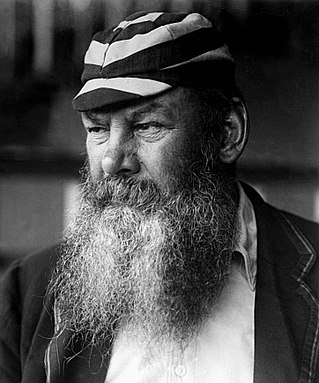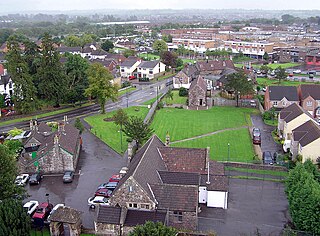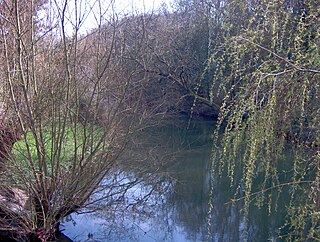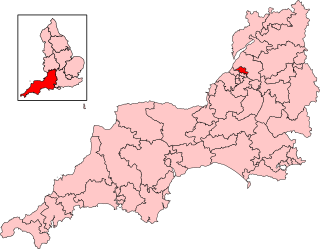
William Gilbert Grace was an English cricketer who is widely considered one of the sport's all-time greatest players. Always known by his initials as "WG", his first-class career spanned a record-equalling 44 seasons from 1865 to 1908. Test cricket originated during his career, and he represented England in 22 matches from 1880 to 1899. In domestic cricket, he was mostly associated with Gloucestershire, the Gentlemen, Marylebone Cricket Club (MCC), and the United South of England Eleven (USEE).

South Gloucestershire is a unitary authority area in the ceremonial county of Gloucestershire, South West England. Towns in the area include Yate, Chipping Sodbury, Kingswood, Thornbury, Filton, Patchway and Bradley Stoke. The southern part of its area falls within the Greater Bristol urban area surrounding the city of Bristol.

Winterbourne is a large village and civil parish in the South Gloucestershire district, in the ceremonial county of Gloucestershire, England, lying just beyond the north fringe of Bristol. The parish of Winterbourne is centred on the village and includes the neighbouring communities of Winterbourne Down, Whiteshill, Hambrook, Frenchay and Watley's End. To the north-east is the village of Frampton Cotterell and to the west lies the town of Bradley Stoke. The parish had a population of 10,250 at the 2021 census.

The Frome, historically the Froom, is a river that rises in Dodington Park, South Gloucestershire and flows southwesterly through Bristol to join the river Avon. It is approximately 20 miles (32 km) long, and the mean flow at Frenchay is 60 cubic feet per second (1.7 m3/s). The name Frome is shared with several other rivers in South West England and means 'fair, fine, brisk'. The river is known locally in east Bristol as the Danny.

Downend is a residential suburb of Greater Bristol, England, the housing stock is typically terraced Victorian, 1930s and 1950s semi-detached and detached. It is in the South Gloucestershire local district, located to the northeast of Bristol and bordered by the Bristol City suburb of Fishponds, and the South Gloucestershire suburbs of Staple Hill, Frenchay, Mangotsfield, and Emersons Green. The community was formerly part of the parish of Mangotsfield. On 19 January 2020 The Sunday Times ran an article which named Downend as one of the UK's best suburbs.

Frampton Cotterell is a village and civil parish in South Gloucestershire, England, on the River Frome. The village is contiguous with Winterbourne to the south-west and Coalpit Heath to the east. The parish borders Iron Acton to the north and Westerleigh to the south-east, the large town of Yate is 2 miles away. The village is 8 miles north-east of Bristol. The population of the village together with the adjoining village of Winterbourne was 14,694 in 2011. The population of the parish alone was 6,520 at the 2011 census.

Edward Mills Grace was an English first-class cricketer in the second half of the 19th century who was an all-rounder, batting right-handed and bowling slow right arm underarm. He played for Gloucestershire County Cricket Club and was the elder brother of W. G. and Fred Grace. All three played for England against Australia in September 1880 two weeks before Fred Grace died. Always known by his initials, E. M. Grace controversially held amateur status but was criticised for the money he made by playing.

Hambrook is a village in the civil parish of Winterbourne, in the South Gloucestershire district, in Gloucestershire, England, situated on the north-eastern outskirts of the city of Bristol. It lies between the larger communities of Winterbourne and Frenchay.

Filton and Bradley Stoke is a constituency represented in the House of Commons of the UK Parliament since 2024 by Claire Hazelgrove from the Labour Party.

Frenchay Hospital was a large hospital situated in Frenchay, South Gloucestershire, on the north east outskirts of Bristol, England, which is now closed. In 2014, it contracted to a few brain and head injuries services. It was managed by North Bristol NHS Trust.

Southmead Hospital is a large public National Health Service hospital, situated in the area of Southmead, though in Horfield ward, in the northern suburbs of Bristol, England. It is part of the North Bristol NHS Trust. The 800-bed Brunel Building opened in May 2014, to provide services, which transferred from Frenchay Hospital in advance of its closure. The hospital site covers 60 acres (24 ha).
John Foster (1770–1843) was an English Baptist minister and essayist.

The Frome Valley Walkway is an 18-mile (29 km) footpath which follows the River Frome from the River Avon in the centre of Bristol to the Cotswold Hills in South Gloucestershire. The path also links the Cotswold Way National Trail at one end with the Avon Walkway at the other.
The city of Bristol, England, is divided into many areas, which often overlap or have non-fixed borders. These include Parliamentary constituencies, council wards and unofficial neighbourhoods. There are no civil parishes in Bristol.

Joseph Storrs Fry (1767–1835) was an English chocolate and confectionery manufacturer and a member of the Fry Family of Bristol, England.

Blackberry Hill Hospital is an NHS psychiatric hospital in Fishponds, Bristol, England, specialising in forensic mental health services, operated by the Avon and Wiltshire Mental Health Partnership NHS Trust. The hospital also offers drug and alcohol rehabilitation inpatient services, and is the base for a number of community mental health teams.
North Bristol NHS Trust is a National Health Service trust that provides community healthcare and hospital services to Bristol, South Gloucestershire, and North Somerset, England. The trust employs over 8,000 staff and delivers healthcare through several medical institutions, including Southmead Hospital, Cossham Hospital, and the Bristol Centre for Enablement, as well as through various community-based clinics. In addition, medical teaching facilities are provided in association with the University of the West of England, Bristol University, and the University of Bath.
Healthcare in the city of Bristol, England and the surrounding area is largely provided by the National Health Service (NHS). Until July 2022, this was provided through the Bristol, North Somerset and South Gloucestershire clinical commissioning group. Facilities include a large teaching hospital – Bristol Royal Infirmary – which offers nationally commissioned specialist cardiac, cancer and children's services from its city-centre campus to patients in the southwest of England and beyond.

Edward Wadham was appointed mineral agent to Walter Montagu Douglas Scott, 5th Duke of Buccleuch in 1851 and later, steward of the Manor of Plain Furness. He kept detailed diaries throughout his adult life, now in the possession of the Cumbria Archive Service, many of which cover the growth and development of the town of Barrow-in-Furness, then in Lancashire now in Cumbria, England.


















